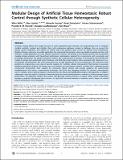Modular Design of Artificial Tissue Homeostasis: Robust Control through Synthetic Cellular Heterogeneity
Author(s)
Miller, Miles Aaron; Hafner, Marc; Sontag, Eduardo; Davidsohn, Noah Justin; Subramanian, Sairam; Purnick, Priscilla E. M.; Lauffenburger, Douglas A.; Weiss, Ron; ... Show more Show less
DownloadMiller-2012-Modular Design of Ar.pdf (3.108Mb)
PUBLISHER_POLICY
Publisher Policy
Article is made available in accordance with the publisher's policy and may be subject to US copyright law. Please refer to the publisher's site for terms of use.
Terms of use
Metadata
Show full item recordAbstract
Synthetic biology efforts have largely focused on small engineered gene networks, yet understanding how to integrate multiple synthetic modules and interface them with endogenous pathways remains a challenge. Here we present the design, system integration, and analysis of several large scale synthetic gene circuits for artificial tissue homeostasis. Diabetes therapy represents a possible application for engineered homeostasis, where genetically programmed stem cells maintain a steady population of β-cells despite continuous turnover. We develop a new iterative process that incorporates modular design principles with hierarchical performance optimization targeted for environments with uncertainty and incomplete information. We employ theoretical analysis and computational simulations of multicellular reaction/diffusion models to design and understand system behavior, and find that certain features often associated with robustness (e.g., multicellular synchronization and noise attenuation) are actually detrimental for tissue homeostasis. We overcome these problems by engineering a new class of genetic modules for ‘synthetic cellular heterogeneity’ that function to generate beneficial population diversity. We design two such modules (an asynchronous genetic oscillator and a signaling throttle mechanism), demonstrate their capacity for enhancing robust control, and provide guidance for experimental implementation with various computational techniques. We found that designing modules for synthetic heterogeneity can be complex, and in general requires a framework for non-linear and multifactorial analysis. Consequently, we adapt a ‘phenotypic sensitivity analysis’ method to determine how functional module behaviors combine to achieve optimal system performance. We ultimately combine this analysis with Bayesian network inference to extract critical, causal relationships between a module's biochemical rate-constants, its high level functional behavior in isolation, and its impact on overall system performance once integrated.
Date issued
2012-07Department
Massachusetts Institute of Technology. Department of Biological Engineering; Massachusetts Institute of Technology. Department of Electrical Engineering and Computer ScienceJournal
PLoS ONE
Publisher
Public Library of Science
Citation
Miller, Miles et al. “Modular Design of Artificial Tissue Homeostasis: Robust Control Through Synthetic Cellular Heterogeneity.” Ed. Greg Tucker-Kellogg. PLoS Computational Biology 8.7 (2012): e1002579.
Version: Final published version
ISSN
1932-6203